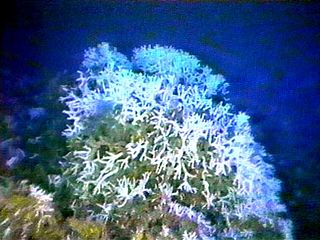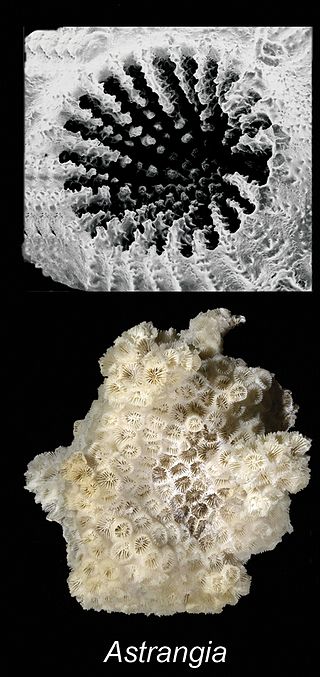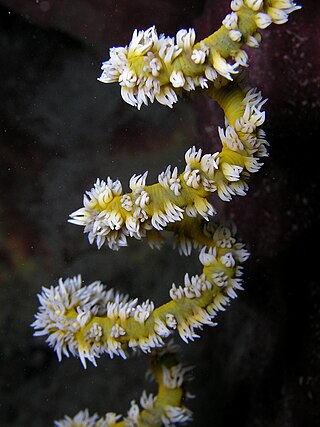
Corals are colonial marine invertebrates within the subphylum Anthozoa of the phylum Cnidaria. They typically form compact colonies of many identical individual polyps. Coral species include the important reef builders that inhabit tropical oceans and secrete calcium carbonate to form a hard skeleton.

Anthozoa is a class of marine invertebrates which includes sessile cnidarians such as the sea anemones, stony corals, soft corals and sea pens. Adult anthozoans are almost all attached to the seabed, while their larvae can disperse as planktons. The basic unit of the adult is the polyp; this consists of a cylindrical column topped by a disc with a central mouth surrounded by tentacles. Sea anemones are mostly solitary, but the majority of corals are colonial, being formed by the budding of new polyps from an original, founding individual. Colonies are strengthened by calcium carbonate and other materials and take various massive, plate-like, bushy or leafy forms.

The aggregating anemone, or clonal anemone, is the most abundant species of sea anemone found on rocky, tide swept shores along the Pacific coast of North America. This cnidarian hosts endosymbiotic algae called zooxanthellae that contribute substantially to primary productivity in the intertidal zone. The aggregating anemone has become a model organism for the study of temperate cnidarian-algal symbioses. They are most well known for the ability to clone themselves.

Zoanthids are an order of cnidarians commonly found in coral reefs, the deep sea and many other marine environments around the world. These animals come in a variety of different colonizing formations and in numerous different colors. They can be found as individual polyps, attached by a fleshy stolon or a mat that can be created from small pieces of sediment, sand and rock. The term "zoanthid" refers to all animals within this order Zoantharia, and should not be confused with "Zoanthus", which is one genus within Zoantharia.

Hexacorallia is a class of Anthozoa comprising approximately 4,300 species of aquatic organisms formed of polyps, generally with 6-fold symmetry. It includes all of the stony corals, most of which are colonial and reef-forming, as well as all sea anemones, and zoanthids, arranged within five extant orders. The hexacorallia are distinguished from another class of Anthozoa, Octocorallia, in having six or fewer axes of symmetry in their body structure; the tentacles are simple and unbranched and normally number more than eight. These organisms are formed of individual soft polyps which in some species live in colonies and can secrete a calcite skeleton. As with all Cnidarians, these organisms have a complex life cycle including a motile planktonic phase and a later characteristic sessile phase. Hexacorallia also include the significant extinct order of rugose corals.

Aiptasia is a genus of a symbiotic cnidarian belonging to the class Anthozoa. Aiptasia is a widely distributed genus of temperate and tropical sea anemones of benthic lifestyle typically found living on mangrove roots and hard substrates. These anemones, as well as many other cnidarian species, often contain symbiotic dinoflagellate unicellular algae of the genus Symbiodinium living inside nutritive cells. The symbionts provide food mainly in the form of lipids and sugars produced from photosynthesis to the host while the hosts provides inorganic nutrients and a constant and protective environment to the algae. Species of Aiptasia are relatively weedy anemones able to withstand a relatively wide range of salinities and other water quality conditions. In the case of A. pallida and A. pulchella, their hardiness coupled with their ability to reproduce very quickly and out-compete other species in culture gives these anemones the status of pest from the perspective of coral reef aquarium hobbyists. These very characteristics make them easy to grow in the laboratory and thus they are extensively used as model organisms for scientific study. In this respect, Aiptasia have contributed a significant amount of knowledge regarding cnidarian biology, especially human understanding of cnidarian-algal symbioses, a biological phenomenon crucial to the survival of corals and coral reef ecosystems. The dependence of coral reefs on the health of the symbiosis is dramatically illustrated by the devastating effects experienced by corals due to the loss of algal symbionts in response to environmental stress, a phenomenon known as coral bleaching.

Corynactis californica is a brightly colored colonial anthozoan corallimorph. Unlike the Atlantic true sea anemone, Actinia fragacea, that bears the same common name, strawberry anemone, this species is a member of the order Corallimorpharia, and is the only member found on the west coast of North America. Other common names include club-tipped anemone and strawberry corallimorpharian. The anemone can live up to at least 50 meters (164 ft) deep on vertical rock walls, and at the bottom of kelp forests. It is known to carpet the bottom of some areas, like Campbell River in British Columbia, and Monterey Bay in California.

Oculina varicosa, or the ivory bush coral, is a scleractinian deep-water coral primarily found at depths of 70-100m, and ranges from Bermuda and Cape Hatteras to the Gulf of Mexico and the Caribbean. Oculina varicosa flourishes at the Oculina Bank off the east coast of Florida, where coral thickets house a variety of marine organisms. The U.S. National Marine Fisheries Service considers Oculina a genus of concern, due to the threat of rapid ocean warming. Species of concern are those species about which the U.S. Government's National Oceanic and Atmospheric Administration (NOAA), National Marine Fisheries Service, has some concerns regarding status and threats, but for which insufficient information is available to indicate a need to list the species under the U.S. Endangered Species Act (ESA). While Oculina is considered a more robust genus in comparison to tropical corals, rising ocean temperatures continue to threaten coral health across the planet.

Sea anemones are a group of predatory marine invertebrates constituting the order Actiniaria. Because of their colourful appearance, they are named after the Anemone, a terrestrial flowering plant. Sea anemones are classified in the phylum Cnidaria, class Anthozoa, subclass Hexacorallia. As cnidarians, sea anemones are related to corals, jellyfish, tube-dwelling anemones, and Hydra. Unlike jellyfish, sea anemones do not have a medusa stage in their life cycle.

Zoanthus sociatus, commonly known as the green sea mat or button polyp, is a zoanthid usually found in shallow reef zones of tropical regions from Caribbean to southeastern Brazil. Z. sociatus is currently being studied for its use against human lymphatic parasites.

Parazoanthus axinellae, commonly known as the yellow cluster anemone, is a zoanthid coral found on the southern Atlantic coasts of Europe and in the Mediterranean Sea. Zoanthids differ from true sea anemones, in having a different internal anatomy and in forming true colonies in which the individual animals (polyps) are connected by a common tissue, called the coenenchyme.

The Cape zoanthid is a species of zoanthid in the family Parazoanthidae.

Umimayanthus parasiticus, commonly known as the sponge zoanthid, is a species of coral in the order Zoantharia which grows symbiotically on several species of sponge. It is found in shallow waters in the Caribbean Sea and the Gulf of Mexico.

Palythoa is a genus of anthozoans in the order Zoantharia.

Astrangia poculata, the northern star coral or northern cup coral, is a species of non-reefbuilding stony coral in the family Rhizangiidae. It is native to shallow water in the western Atlantic Ocean and the Caribbean Sea. The International Union for Conservation of Nature lists this coral as being of "least concern". Astrangia poculata is an emerging model organism for corals because it harbors a facultative photosymbiosis, is a calcifying coral, and has a large geographic range. Research on this emerging model system is showcased annually by the Astrangia Research Working Group, collaboratively hosted by Roger Williams University, Boston University, and Southern Connecticut State University

Palythoa toxica, also referred to by its Hawaiian common name, limu-make-o-Hana, is a species of zoanthid native to Hawaii. It is notable as the species in which palytoxin was discovered and from which it was first isolated.

Cirrhipathes is a genus of black coral from the family Antipathidae. Coral species in this genus are commonly known as whip or wire corals because they often exhibit a twisted or coiled morphology. In addition to their colorful appearance, with colors ranging from yellow to red passing through blue and green, these species possess a dark skeleton that is characteristic to every black coral.

Coelastrea aspera is a species of stony coral in the family Merulinidae. It is a colonial species native to the Indo-Pacific region where it occurs in shallow water. It was first described by the American zoologist Addison Emery Verrill in 1866 as Goniastrea aspera but it has since been determined that it should be in a different genus and its scientific name has been changed to Coelastrea aspera. This is a common species throughout much of its wide range and the International Union for Conservation of Nature has rated its conservation status as being of "least concern".

Savalia savaglia, commonly known as gold coral, is a species of colonial false black coral in the family Parazoanthidae. It is native to the northeastern Atlantic Ocean and the Mediterranean Sea where it often grows in association with a gorgonian. It is extremely long-lived, with a lifespan of 2,700 years, and develops into a large tree-like colony.

Parazoanthus darwini is a species of macrocnemic zoanthid first found in the Galapagos. It can be distinguished by its association with sponges, by having about 24–30 tentacles and polyps embedded in a well-developed coenenchyme.



















